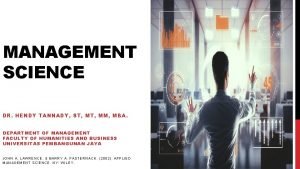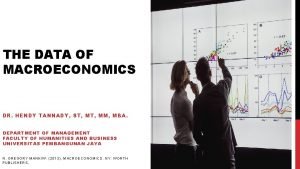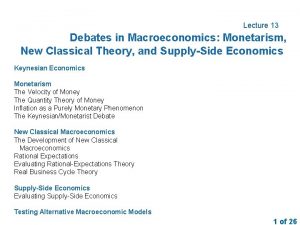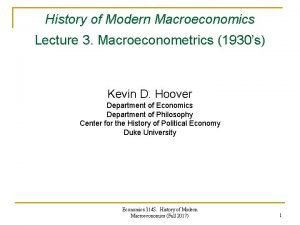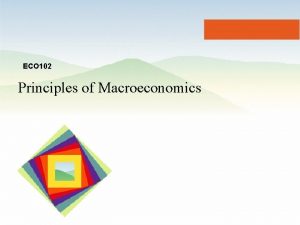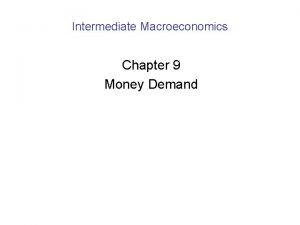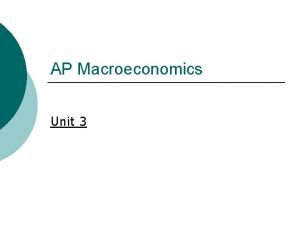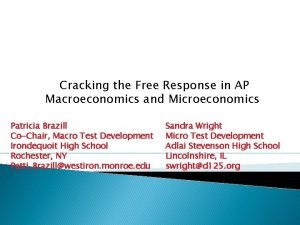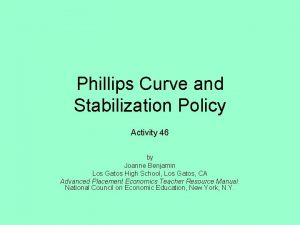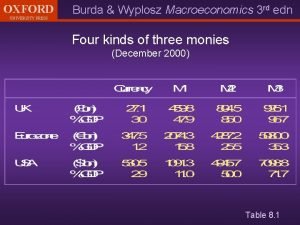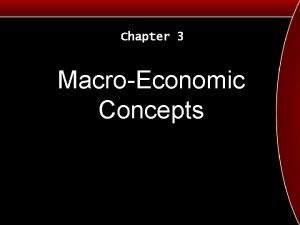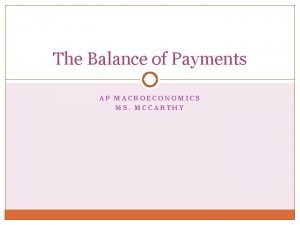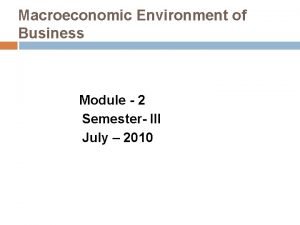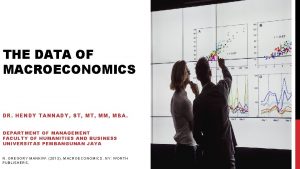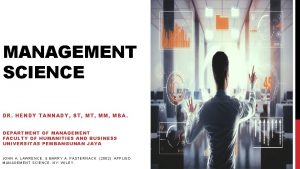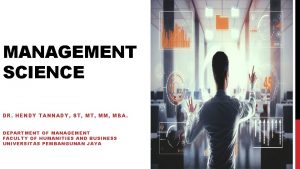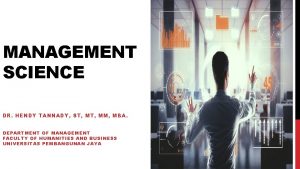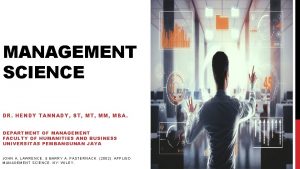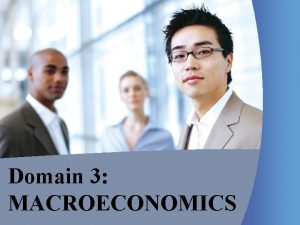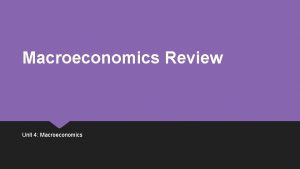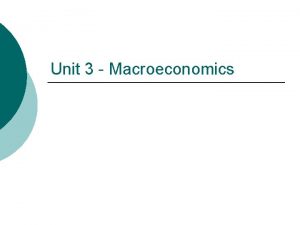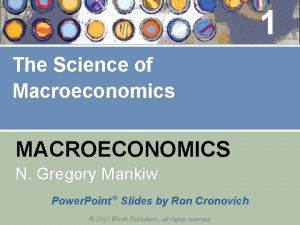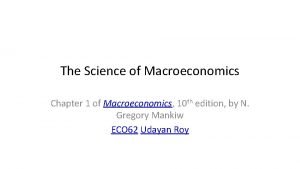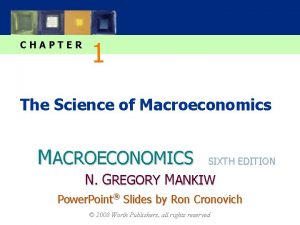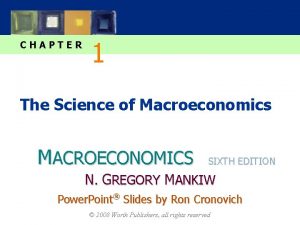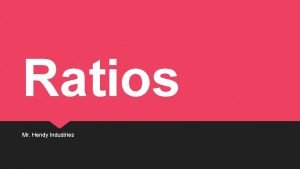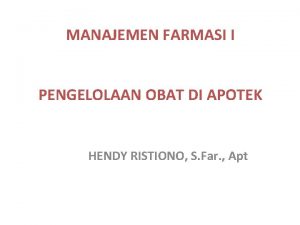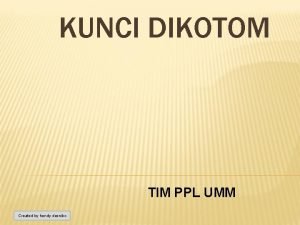THE SCIENCE OF MACROECONOMICS DR HENDY TANNADY ST























- Slides: 23

THE SCIENCE OF MACROECONOMICS DR. HENDY TANNADY, ST, MM, MBA. DEPARTMENT OF MANAGEMENT FACULTY OF HUMANITIES AND BUSINESS UNIVERSITAS PEMBANGUNAN JAYA N. GREGORY MANKIW. (2013). MACROECONOMICS. NY: WORTH PUBLISHERS.

1. WHAT MACROECONOMIST STUDY

1. WHAT MACROECONOMIST STUDY Why have some countries experienced rapid growth in incomes over the past century while others stay mired in poverty? Why do some countries have high rates of inflation while others maintain stable prices? Why do all countries experience recessions and depressions—recurrent periods of falling incomes and rising unemployment—and how can government policy reduce the frequency and severity of these episodes? Macroeconomics attempts to answer these and many related questions.

1. WHAT MACROECONOMIST STUDY These macroeconomic events may seem abstract, but they touch all of our lives. Business executives forecasting the demand for their products must guess how fast consumers’ incomes will grow. Senior citizens living on fixed incomes wonder how fast prices will rise. Recent college graduates looking for jobs hope that the economy will boom and that firms will be hiring.

1. WHAT MACROECONOMIST STUDY Because the state of the economy affects everyone, macroeconomic issues play a central role in national political debates. Voters are aware of how the economy is doing, and they know that government policy can affect the economy in powerful ways. As a result, the popularity of an incumbent president often rises when the economy is doing well and falls when it is doing poorly.

1. WHAT MACROECONOMIST STUDY THE HISTORICAL PERFORMANCE OF THE U. S. ECONOMY Economists use many types of data to measure the performance of an economy. Three macroeconomic variables are especially important: real gross domestic product (GDP), the inflation rate, and the unemployment rate. Real GDP measures the total income of everyone in the economy (adjusted for the level of prices). The inflation rate measures how fast prices are rising. The unemployment rate measures the fraction of the labor force that is out of work. Macroeconomists study how these variables are determined, why they change over time, and how they interact with one another.

1. WHAT MACROECONOMIST STUDY The Great Depression ‘MALAISE’ 1930 s

1. WHAT MACROECONOMIST STUDY Figure 1 -1 shows real GDP person in the United States. Two aspects of this fi gure are noteworthy. First, real GDP grows over time. Real GDP person today is about eight times higher than it was in 1900. This growth in average income allows us to enjoy a much higher standard of living than our greatgrandparents did. There are repeated periods during which real GDP falls, the most dramatic instance being the early 1930 s. Such periods are called recessions if they are mild and depressions if they are more severe. Not surprisingly, periods of declining income are associated with substantial economic hardship

1. WHAT MACROECONOMIST STUDY Figure 1 -2 shows the U. S. infl ation rate. You can see that infl ation varies substantially over time. In the first half of the twentieth century, the inflation rate averaged only slightly above zero. Periods of falling prices, called deflation, were almost as common as periods of rising prices.

1. WHAT MACROECONOMIST STUDY Figure 1 -3 shows the U. S. unemployment rate. Notice that there is always some unemployment in the economy. In addition, although the unemployment rate has no long-term trend, it varies substantially from year to year. The highest rates of unemployment were reached during the Great Depression of the 1930 s.

2. HOW ECONOMIST THINK THEORY AS MODEL BUILDING Young children learn much about the world around them by playing with toy versions of real objects. For instance, they often put together models of cars, trains, or planes. These models are far from realistic, but the model-builder learns a lot from them nonetheless. The model illustrates the essence of the real object it is designed to resemble. (In addition, for many children, building models is fun. ) Economists also use models to understand the world, but an economist’s model is more likely to be made of symbols and equations than plastic and glue. Economists build their “toy economies” to help explain economic variables, such as GDP, infl ation, and unemployment. Economic models illustrate, often in mathematical terms, the relationships among the variables. Models are useful because they help us dispense with irrelevant details and focus on underlying connections. (In addition, for many economists, building models is fun. ) Models have two kinds of variables: endogenous variables and exogenous variables. Endogenous variables are those variables that a model tries to explain. Exogenous variables are those variables that a model takes as given. The purpose of a model is to show the exogenous variables affect the endogenous variables.

2. HOW ECONOMIST THINK THEORY AS MODEL BUILDING For example, the economist supposes that the quantity of pizza demanded by consumers Qd depends on the price of pizza P and on aggregate income Y. This relationship is expressed in the equation Qd = D(P, Y) where D( ) represents the demand function

2. HOW ECONOMIST THINK THEORY AS MODEL BUILDING Similarly, the economist supposes that the quantity of pizza supplied by pizzerias Qs depends on the price of pizza P and on the price of materials Pm, such as cheese, tomatoes, flour, and anchovies. This relationship is expressed as Qs = S(P, Pm) where S( ) represents the supply function

2. HOW ECONOMIST THINK THEORY AS MODEL BUILDING Finally, the economist assumes that the price of pizza adjusts to bring the quantity supplied and quantity demanded into balance: Qs = Qd

2. HOW ECONOMIST THINK THEORY AS MODEL BUILDING

2. HOW ECONOMIST THINK THEORY AS MODEL BUILDING A rise in aggregate income causes the demand for pizza to increase: at any given price, consumers now want to buy more pizza. This is represented by a rightward shift in the demand curve from D 1 to D 2.

2. HOW ECONOMIST THINK THEORY AS MODEL BUILDING In panel (b), a rise in the price of materials decreases the supply of pizza: at any given price, pizzerias fi nd that the sale of pizza is less profi table and therefore choose to produce less pizza.

2. HOW ECONOMIST THINK

2. HOW ECONOMIST THINK THE USE OF MULTIPLE MODELS Macroeconomists study many facets of the economy. For example, they examine the role of saving in economic growth, the impact of minimumwage laws on unemployment, the effect of inflation on interest rates, and the influence of trade policy on the trade balance and exchange rate. Economists use models to address all of these issues, but no single model can answer every question. Just as carpenters use different tools for different tasks, economists use different models to explain different economic phenomena. Students of macroeconomics therefore must keep in mind that there is no single “correct’’ model that is always applicable. Instead, there are many models, each of which is useful for shedding light on a different facet of the economy. The field of macroeconomics is like a Swiss army knife—a set of complementary but distinct tools that can be applied in different ways in different circumstances.

2. HOW ECONOMIST THINK PRICES: FLEXIBLE VERSUS STICKY Throughout this book, one group of assumptions will prove especially important— those concerning the speed at which wages and prices adjust to changing economic conditions. Economists normally presume that the price of a good or a service moves quickly to bring quantity supplied and quantity demanded into balance. In other words, they assume that markets are normally in equilibrium, so the price of any good or service is found where the supply and demand curves intersect. This assumption, called MARKET CLEARING, is central to the model of the pizza market discussed earlier. For answering most questions, economists use market-clearing models. Yet the assumption of continuous market clearing is not entirely realistic. For markets to clear continuously, prices must adjust instantly to changes in supply and demand. In fact, many wages and prices adjust slowly. Labor contracts often set wages for up to three years

2. HOW ECONOMIST THINK MICROECONOMIC THINGKING AND MACROECONOMIC MODELS Microeconomics is the study of how households and firms make decisions and how these decisionmakers interact in the marketplace. A central principle of microeconomics is that households and firms optimize—they do the best they can for themselves given their objectives and the constraints they face. In microeconomic models, households choose their purchases to maximize their level of satisfaction, which economists call utility, and fi rms make production decisions to maximize their profits.

THANK YOU

PROBLEMS 1. Explain the difference between macroeconomics and microeconomics. How are these two fields related ? 2. Why do economists build models ? 3. What is a market-clearing model? When is it appropriate to assume that markets clear? 4. Please explain several exogeneous variables to predict profit of restaurant or cafetaria around your domicile ?
 Hendy tannady
Hendy tannady Hendy tannady
Hendy tannady The inca government
The inca government Ruth hendy
Ruth hendy Why is science my favourite subject
Why is science my favourite subject Monetarist vs classical economics
Monetarist vs classical economics Macroeconomics
Macroeconomics Macroeconometrics
Macroeconometrics Macroeconomics
Macroeconomics Micro and macro economics venn diagram
Micro and macro economics venn diagram Money demand
Money demand Ap macro unit 3
Ap macro unit 3 Transfer payments
Transfer payments 2012 macroeconomics frq
2012 macroeconomics frq Macroeconomics
Macroeconomics Macroeconomics
Macroeconomics Seasonal unemployment example
Seasonal unemployment example Macroeconomics lesson 3 activity 46
Macroeconomics lesson 3 activity 46 Expansionary fiscal policy graph
Expansionary fiscal policy graph Mankiw macroeconomics 9th edition
Mankiw macroeconomics 9th edition Burda macroeconomics
Burda macroeconomics Macroeconomics deals with?
Macroeconomics deals with? Ap macroeconomics balance of payments
Ap macroeconomics balance of payments Scope of macroeconomics
Scope of macroeconomics
